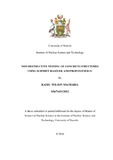| dc.description.abstract | Kenya has been facing various and sometimes serious durability problems in concrete buildings. In the past ten years alone, more than fourteen buildings have collapsed. The causes of these failures have been in most cases attributed to poor workmanship, as well as poor quality of the materials used during the construction of these buildings. This in turn results in poor quality structures that eventually fail leading to injuries, deaths and loss of money. The long term development goals for Kenya, under Vision 2030, feature a key component on infrastructure development. The infrastructure will require a high degree of structural safety, longevity and performance. To guarantee safety and durability in these developments, an effective technique for early and frequent structural assessments, is both dependable and reliable, is required to provide assessment and quality assurance of these structures. Non-destructive techniques possess a tremendous potential to be part of that system.
This study reports non-destructive testing measurements of concrete compressive strength using a laboratory pre-calibrated Schmidt rebound hammer, while rebar diameter, location and cover were measured using a Profometer 5+ Covermeter, as well as test reliability of this tools to the task. Laboratory calibration involved preparation of 60 cubes of concrete specimens at 5 different classes of concrete mix proportions. The compressive strengths of these cubes were assessed using a Denison Compressive Testing Machine. Data obtained from hammer measurements were plotted against related Denison data, and a calibration equation y=0.9x generated using least square fitting at a correlation coefficient of 0.8. This equation was the used to obtain in-situ strength properties of new and old concrete structures.
The Profometer was able to locate the exact position of the bar with a high level of accuracy. The equipment was also able to measure the size of the reinforcement bars and its cover, provided that they are located at 60 mm depth or less from the measuring surface. These methods were later used to conduct structural test in two residential and three commercial buildings within Nairobi city. Higher compressive strengths were recorded in commercial buildings as compared to the residential ones. The obtained data can be compared with the structural design to check for compliance.
In conclusion, the two methods proved to be fast, inexpensive and non-destructive in nature, and can be an important tool for monitoring the integrity of concrete structures
v
throughout their design life to assure their safety and durability. However, the two tools had their own shortcomings. The performance of Schmidt hammer was found to be affected by plastering. To obtain more reliable results, it is recommended to remove the plaster coating prior to testing. As for Profometer 5+, its efficiency was found to decline at cover depths > 60 mm, and when the rebars are closely spaced. | en_US |



